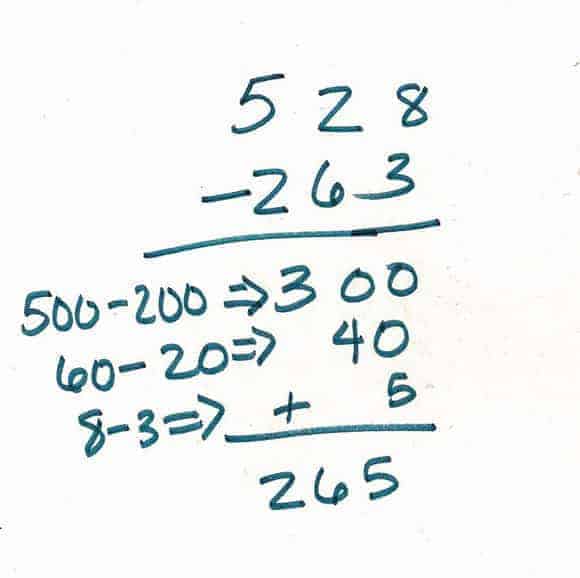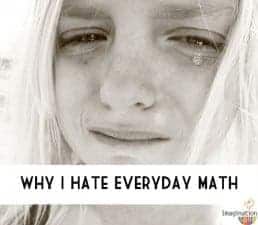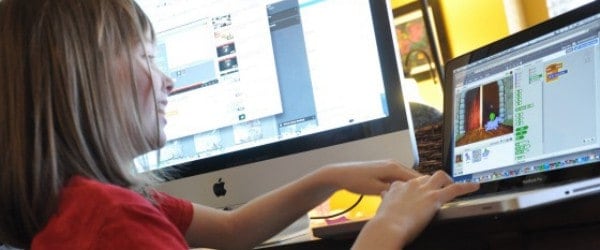Everyday Math Makes Me Want to SCREAM
This post may contain affiliate links.
I don’t normally loathe things. But I loathe Everyday Math for the hell it put my daughter through and the poor math foundation it gave her.
Thank you so much.
You Don’t Know How to Subtract, Mom
My breaking point came one Tuesday evening. My sobbing seven-year old daughter told me I didn’t know how to subtract. To learn, I needed to read the four page Powerpoint presentation on her teacher’s website. (Here’s another teacher’s Power Point.) Four. Pages. ABOUT SUBTRACTION. (But, um, I do know how to subtract, don’t I?)
So, like any normal parent, while opening up the file, I ranted on Facebook.
(Did you know there’s a Facebook support group for people like me? –Parents Against Everyday Math.)
Her subtraction was backwards.
It looked like this:

Now, this kind of method is fine for mental math, sure. But NOT for pencil and paper algorithms – it’s confusing and takes too long!
To make matters worse, it’s certainly NOT a good foundation if the math curriculum doesn’t continue like this through middle and high school. A Facebook friend wrote, “After 6 years of homework battles in elementary school, kids get to un-learn [Everyday Math] in middle school with traditional math. How does that make sense to anyone other than the self-appointed Einstein raking it in?”
Everyday Math Leaves Kids Behind
It was bad enough in first grade when AJ didn’t learn money in the one week it was taught, or time in the one week that was taught, or the addition facts when they were taught. She fell farther and farther behind with the promise that the curriculum would spiral back around eventually.
Her teachers through out these years reassured me that, she’d catch on when she was ready and that the research on Everyday Math was extensive, and it was a really a good way to teach math.
[Insert bad word here that starts with BS.]
Because those statements weren’t true. Not good research. Nor did she catch on eventually. (Google EM research and you’ll see, I’m not going to go into it here.)
Since AJ hadn’t learned the basics, she couldn’t catch on to the next spiral months or a year later.
She believed she was stupid.
Conversely, students who excelled in math weren’t challenged at their ability level and were bored. Herein lies a big problem with Everyday Math — it teaches to the middle so you hit the middle kids and leave out the rest.
Blame the Teacher?
An Everyday Math trainer told my friend that it must be because the teachers were incorrectly implementing the curriculum.
Is the curriculum that easy to mess up?
I don’t think so.
. . .
New Math
In a recent phone conversation, Audra Haskins, Director of Lower School at Aspen Academy in Colorado, explained this about Everyday Math, “It doesn’t go deep; there’s not a lot of repetition, review, or application.”
A teacher friend of mine from Twitter added, “The material jumps around so much that mastery is not achieved on any level (at least in second grade.) It doesn’t make sense. I hate it! I am worried about the future of my students because I felt like I didn’t teach solid math this year.”
Investigations is another curriculum in the New Math genre.
Haskins said, “Investigations is designed to assume the kids are good at math and know the skills and apply them. If kids don’t know it, they’re never going to get there.”
Mom of eight and blogger, Gretchen White commented on Facebook, “I LOATHE Investigations. I’ve ranted about it extensively. It’s the main reason we left our former school. I remember our 2nd grader having to count the pockets in our family for homework one night and I realized it was failing him as a mathematician. I’ve been happy with Saxon, although I know there are plenty of Saxon critics. It seems like “real” math, for lack of a better word.”
 Want to read more concerns about Everyday Math? Try Concerned CT Parent, Ed Weekly Blogger, Rational American, Amy Johnson, Andrea Merida, parents on this forum, Rox Dover, and Parent Pundit.
Want to read more concerns about Everyday Math? Try Concerned CT Parent, Ed Weekly Blogger, Rational American, Amy Johnson, Andrea Merida, parents on this forum, Rox Dover, and Parent Pundit.
To summarize,
3 Reasons I Hate Everyday Math
- Everyday Math does not teach basic number sense.
- Everyday Math makes simple math operations harder than necessary.
- Everyday Math does not differentiate for kids who need longer time or kids who need to move faster.
Cue Music, Enter . . . Singapore Math
We moved schools to one with a FANTASTIC math curriculum — Singapore Math. It goes deep into twelve concepts and teaches to mastery (meaning that kids learn it before moving to a new concept.) Tomorrow I share my happy experiences with Singapore Math. 🙂
What does your school use for math? Or homeschool? What do you like or dislike about it?







Everyday Math is one of the worst math programs in this country. Kids are reaching Middle school and unable to do standard procedures that children should know. https://www.facebook.com/pages/Parents-Against-Everyday-Math/37453309495
Okay…I really just meant to suggest some good math resources, but got a little carried away–sorry!
I use “It Makes Sense” a lot in 2nd grade. There are two K-2 books–one with ten frames and one with the 100 chart. It helps number sense and has several activities, games, and routines. We also use activities from Teaching K-3 Math by Van deWalle, in addition to investigations. I piloted Everyday Math for a month and didn’t like it. It’s just a different version of the “traditional” math, I thought. I’ve studied teaching math a ton for the past 5 years, and I believe in constructivist math. I’ve always liked Investigations because the focus is understanding not memorizing procedures, and kids get to experience math through activities.
For the powerpoint you mentioned–I am sure a powerpoint would twice as long to teach the traditional subtraction procedure…and that would probably exclude actually explaining WHY you “borrow”. Using a place value method similar to the one you showed above actually makes a lot more sense than the traditional. You are not subtracting each ‘digit’, but you are thinking about the whole number and how much it is worth. You are also more likely to catch yourself if the answer does not make sense. No procedure will be very successful if the teacher is simply modeling the steps and having kids copy it. There’s no understanding there.
Think about the last thing you learned (mine is using a zero turn lawnmower!). Did you learn it by someone telling you how to do it once? Probably not–everything my husband said went right over my head. You had to experience it for yourself and work it out. So that said, I’m sure that everyday math procedure your kid had to use was modeled by the teacher a few times then they had to do it. Not at all what it should be like.
All in all, ANY procedure that kids are exposed to needs to be modeled with tools like base ten blocks. And ANY procedure that is used MUST be understood if they are to use it. I don’t tell the kids how to do math, I design lessons where they figure it out, and they communicate it to the class. Our learning comes at the end of math class when we have “share time”. I have researched and went through a lot of training with an amazing teacher. I took a good 3 years of being immersed in constructivist math to be really good at it, and I absolutely LOVE it. And I am a kid that loved doing worksheets and traditional algorithms were easy for me, and I have completely changed my perspective on how to teach math.
The problem with Everyday Math, and the traditional math we all learned, is that there is 1 lesson to teach a procedure. Teachers need to make sure they go deep with a concept, and again the conceptual understanding needs to be solid before using a procedure.
Teach basic facts by playing games. In a good game, they are typically practicing many basic facts in one ‘turn’. Kids are also more motivated, and a big problem that we have in America is that so many people hate math or think they are not good at math. We have to make it fun, and understanding needs to be at the core.
Also, in learning basic facts they need to explore, share, model (on a ten frame).. strategies that help you learn your basic facts like doubles, near doubles, making ten, adding 9/adding 10, and using a nearby known fact.
Alright I better just stop or I could be doing this all night. 🙂
Just wait, our middle school and high school continued constructive math at their levels. My daughter, a freshman in college, is now being remediated in math!
oh, that’s awful.
Mental maths without textbooks up to about 12yo is great too – keeps the joy of maths alive. There’s more than one way to teach the Basics – and it can all be taught in a few months at high school age. No wonder no-one enjoys playing with numbers. ~ Try googling [images] “Fractals” – see I told you numbers are beautiful. 😉
I am a third grade teacher who has taught EM for the past 13 years. While I recognize that there are gaps in EM, for the most part our students have done extremely well with the program. Our district scores are high. As a teacher, you have to know your students. When they struggle, you cannot be so rigid as to not be able to stop and reteach a lesson or supplement with other materials. Some math operations need extra “skill and drill” that the program does not offer, but otherwise it is a pretty good program. It is a program that is differentiated and gives many stragegies to help all students be able to learn and be successful.